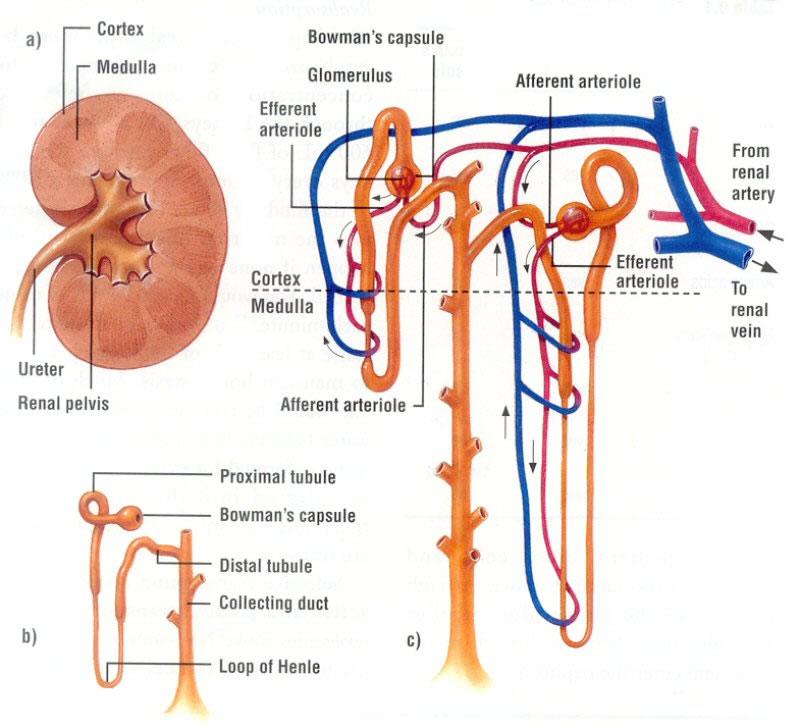 |
| Figure 1 |
Figure 1 shows the structure of a nephron. Its main features are:
- the glomerulus
- the bowman's capsule
- convoluted tubules
- the loop of Henle
- the collecting duct
Blood enters the nephron through the glomerulus. Here, some liquid is 'squeezed' out of the blood due to the high pressure. This is known as the filtrate. Large particles / cells such as erythrocytes (red blood cells) and large amino acids are not filtered. Instead, they continue in small blood vessels. Glucose is also re-absorbed immediately into the capillaries. The filtrate goes into the bowman's capsule and that is where the filtering process begins.
The beginning is in the renal cortex and consists of the glomerulus and the bowman's capsule which surrounds it. The bowman's capsule is a cup-shaped structure that takes in the filtrate while the glomerulus is a 'knot' of capillaries in the middle. The bowman's capsule is the starting point for the filtrate.
The glomerulus is directly connected to the proximal tubule, which is the first convoluted tubule. It's basically a windy tube where mainly organic solutes are re-absorbed, along with water and things like glucose, amino acids, sodium and potassium among others.
After the Loop of Henlé, it reaches the distal tubule, which is the farther-away-curly-tube, aka the second convoluted tubule. Here, the levels of potassium, calcium and sodium are regulated. This is done by pumps and hormones. Once it is done, all of the wanted particles, water, salt, etc. have been taken out, which leaves excess water, urea and other types of metabolic waste.

The Loop of Henlé dips down into the renal medulla and is a hairpin shaped tubule. The upper section is in the outer medulla and the lower section in the inner medulla. It extracts mainly water as it travels down into the medulla. On its way up, it pumps out the salts that the body needs. This causes the medulla to become really really salty and creates a concentration gradient (medulla becomes hypertonic). The further down you go, the saltier it is. In the descending end, the membrane is highly permeable to water. Not really to salt or anything else. When the filtrate gets to the bottom of the loop (because the inner medulla is so so salty) it's highly concentrated. In the ascending end of the loop, the process happens in reverse. Here, the membrane is not-so-permeable to water and instead is lined with channels that transport ions like potassium, sodium and chlorine.

The collecting duct spans both the cortex and the medulla. In the bottom section (in the medulla), because the outside is hypertonic, even more water can be extracted (follows rules of osmosis). Hormones tell the collecting ducts how porous to make their membranes. If a membrane is made very porous, more water is absorbed into the medulla and the urine becomes even more concentrated. If the membrane is made not-very-porous, less or no water is absorbed so the urine is less concentrated.






















